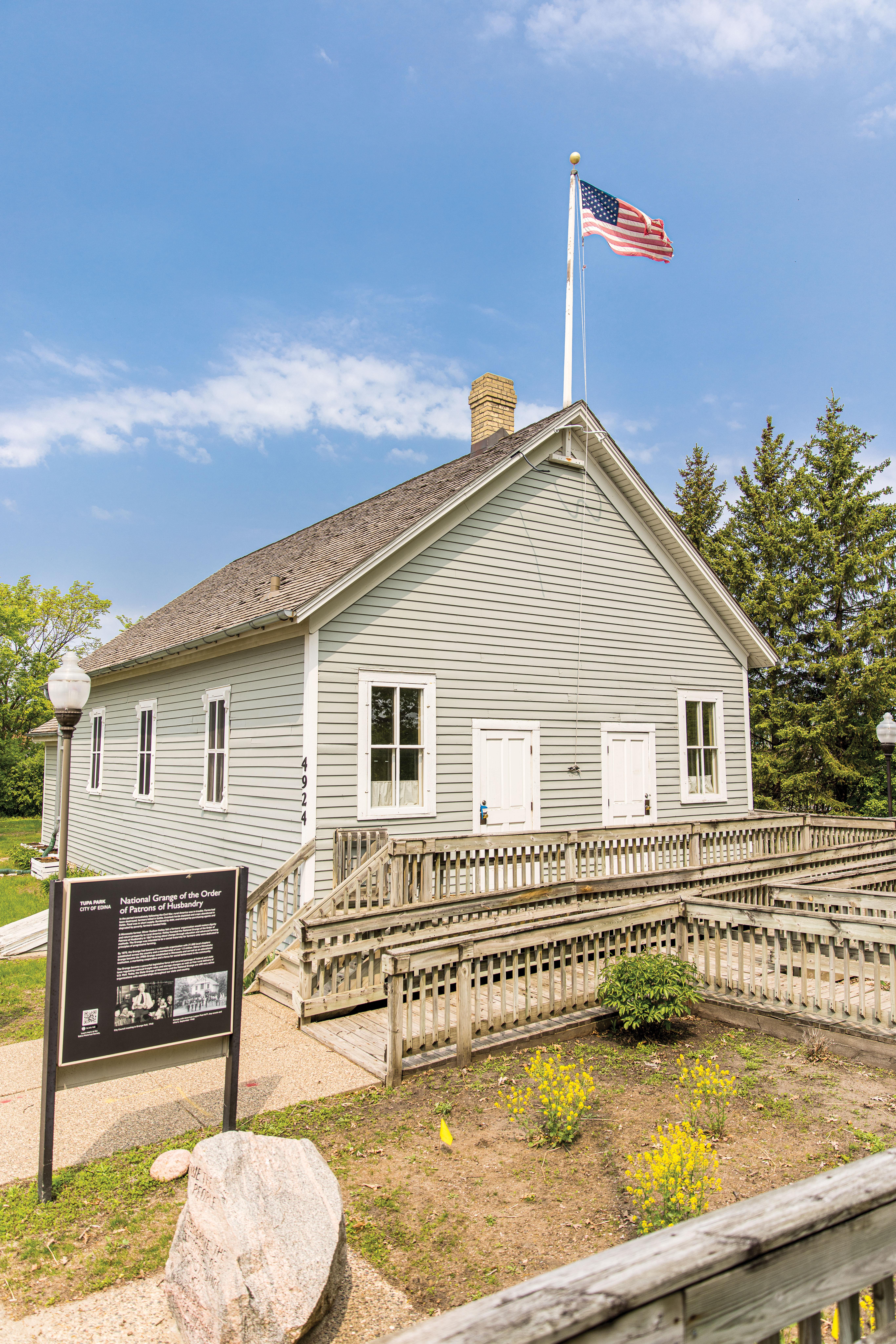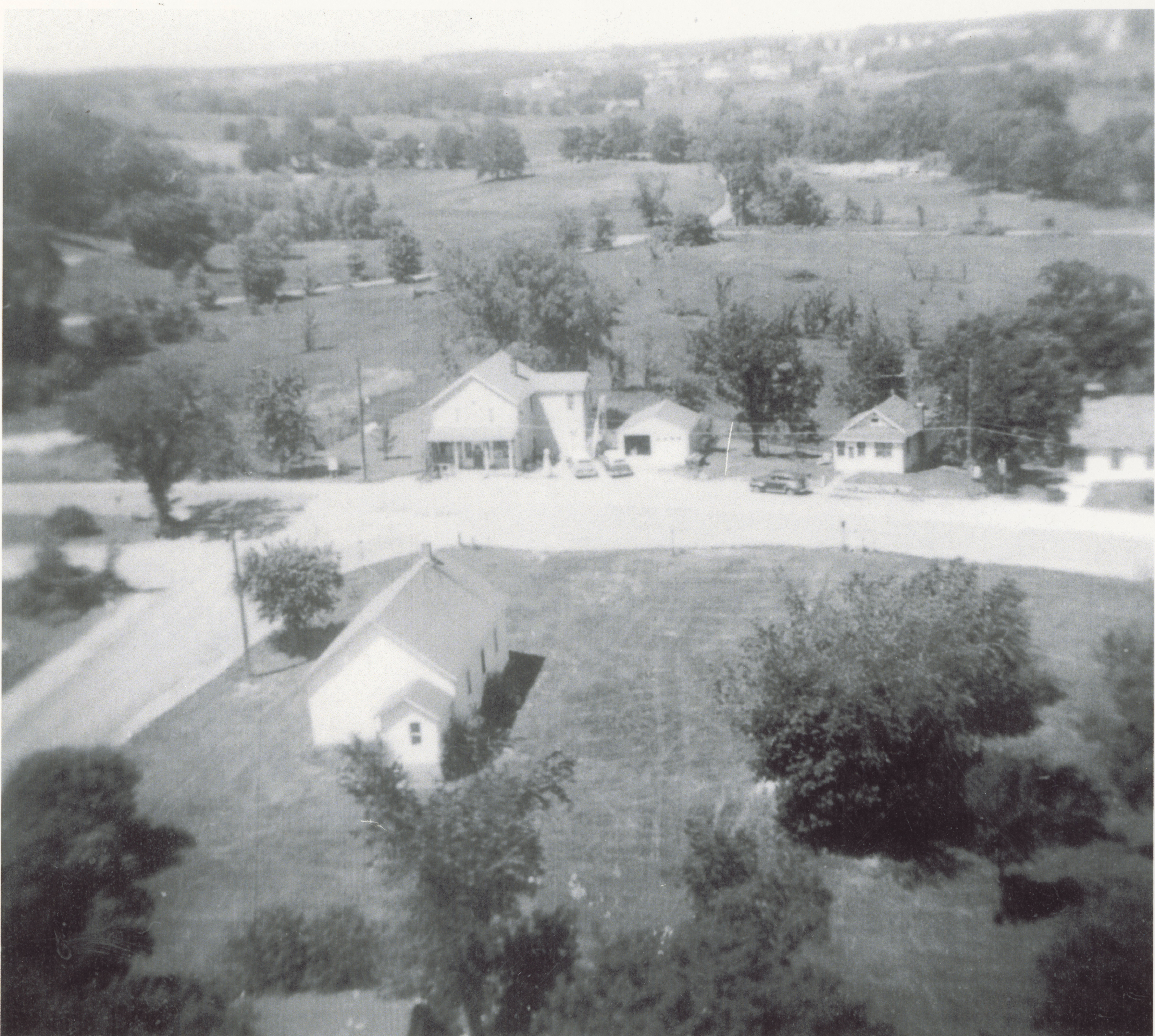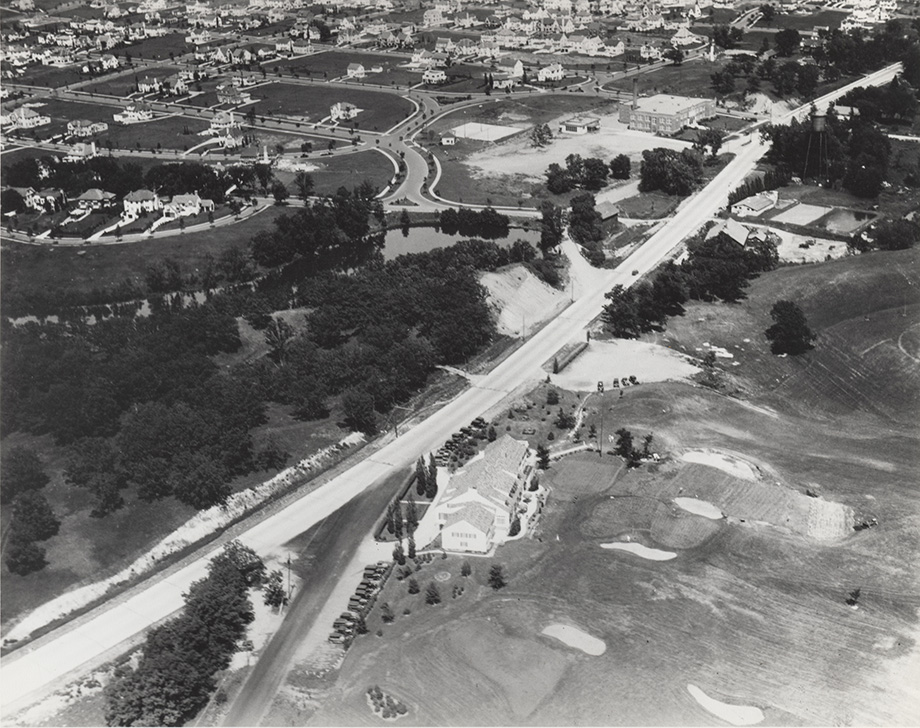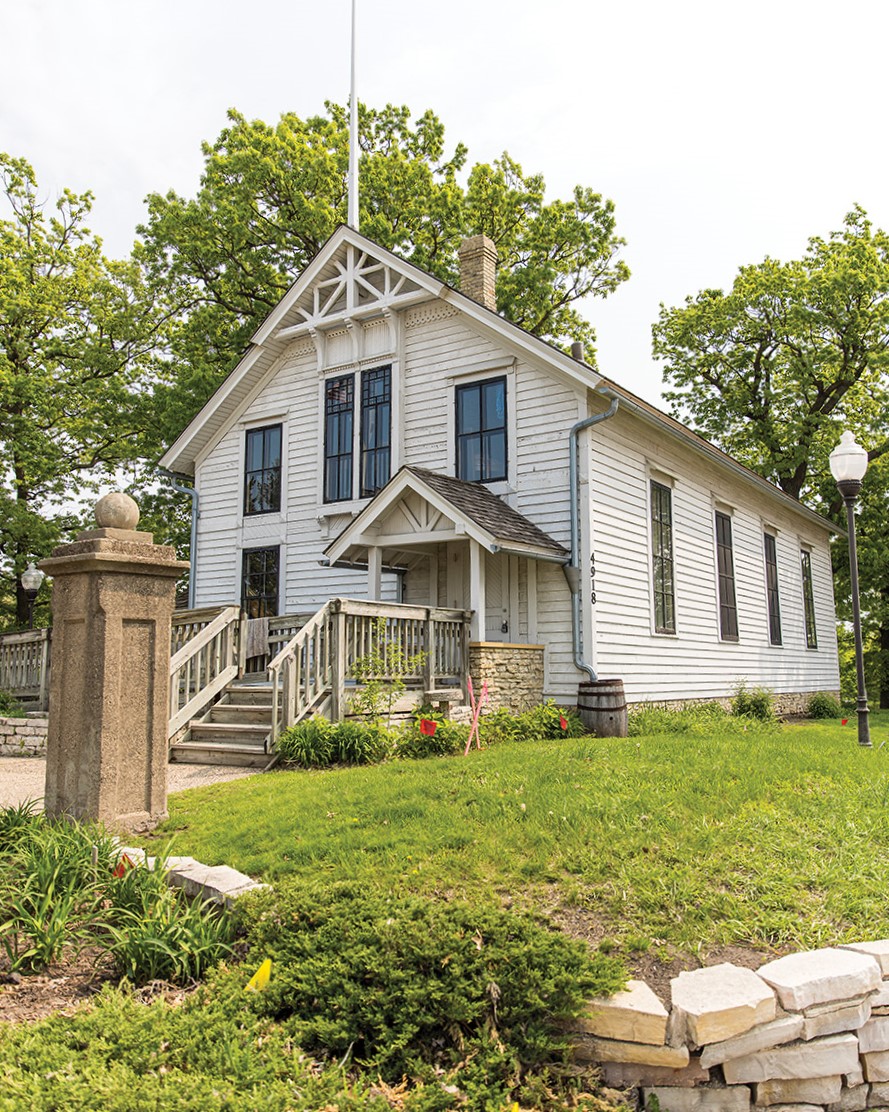
Cahill School in its current location on Eden Avenue. Photo: Chris Emeott
Discover the origin story of Edina, and visit a few historic sites along the way.
Today, Edina is home to over 53,000 residents with over 40 distinct neighborhoods. But when Edina incorporated as a village 135 years ago, in 1888, there were just two main settlements and 485 residents; it was largely farmland centered around local waterways.
As someone who enjoys history, I thought it would be fun to use my Editor’s Picks feature in our Best of Edina issue to take you on a tour of various historic sites around the city that were important both leading up to incorporation and in the first 50 years of the city’s history.
I chatted with John Flynn, the research coordinator at the Edina Historical Society, to learn more about the city’s origins—including some of the earliest settlements and neighborhoods, historic sites that have stood the test of time and insight into where Edina got its name (and what it was almost named instead).
Where it Started:
The Cahill Community
In the mid-1850s, a group of Irish Catholics, who were fleeing the potato famine in Ireland, settled along Nine-Mile Creek, near West 70th Street and Cahill Road and the surrounding area. This was the first group of people to settle in modern-day Edina.
Cahill School
Most of the settlers were farmers, and Flynn says the St. Patrick’s Catholic Church community and the Cahill School, built in 1864, were the heart of their settlement. From 1864–1884, the school building housed the congregation on Sundays, and it was also a central meeting place for the community, serving as a community center of sorts for meetings, dances and other social activities when school wasn’t in session.

Cahill School in 1935. Photos: Edina Historical Society
According to city records, “Cahill School continued to serve children of all ages until the 1950s, even as the new planned communities of Morningside and the Country Club District built new, more modern schools for their children. In 1958, historic Cahill School closed, and students were moved to a new brick school house on West 70th Street, also named Cahill School (which has since been torn down to make room for housing). In the 1960s, the City of Edina acquired the historic school building and moved it to its current location.”

Cahill School in the 1950s
Today, residents can visit the Cahill School structure at 4924 Eden Ave. in Frank Tupa Park. The Edina Historical Society offers field trips to Cahill School, giving students an authentic experience of a school day in a one-room schoolhouse; it also offers homestead camps throughout the summer.
In 1970, the Cahill School was added to the National Park Service’s National Register of Historic Places in recognition of the fact that it’s one of the few remaining one-room schoolhouses in Minnesota and its significance as a community gathering place for the Cahill community throughout the second half of the 19th century.
Early Industry:
The Edina Mills District
“The second group of people settled over where [Minnehaha] Creek crosses under 50th Street—basically more or less the Country Club area,” Flynn says, noting that this group also settled in the area in the mid-1850s and were Protestants and were mostly born in this country.
The Edina Mills
Seeking to harness the creek as a power source for industrial use, individuals from this group of settlers helped establish The Edina Mills (then called the Waterville Mill) in 1857, which was located near where today’s West 50th Street and Browndale Avenues intersect. Other than the mill, there were three other community structures in this settlement: a blacksmith, a general store and, eventually, The Minnehaha Grange Number 398 (or Grange Hall).
“What happened in 1857 was, because they had those established structures there, there were some men who platted the area,” Flynn says, noting that the area was about 10 acres, encompassing the area of today’s Williams, Wooddale and Utley parks.

Edina around 1930. Wooddale School, built in 1926, is near the upper right corner. The other difference is that it shows West 50th Street—the fork in the road next to the golf course is the junction of Eden Avenue and 50th Street. Edina Mills can be seen just to the right of the water. It’s partially obstructed by a tree.
“These men wanted to basically make a city out of just this little area, and they were going to call it Waterville,” he says. “… There was a nationwide financial panic in 1857 … and [the plat] never got filed with Hennepin County … I think that, had that financial panic not happened, it’s very possible that we could be known as Waterville today instead of Edina.” However, the area continued to be called Waterville for the next 15–20 years.
The mill started out as an active grist mill and later processed wheat, corn, rye, oats and barley for the local market, according to city records—which also note that during the early years of the Civil War, the mill ran
24 hours a day to meet the demands of the U.S. Army at Fort Snelling.
About a decade later, the mill was renamed Edina Mills. At that time, it was under the ownership of Andrew Craik, who named it after his native Edinburgh, Scotland—with “Edina,” specifically, pulled from a poem by Robert Burns called Address To Edinburgh, which the poet wrote shortly after arriving in the Scottish city.
“Thy sons, Edina, social, kind,
With open arms the stranger hail;
Their views enlarg’d, their liberal mind,
Above the narrow, rural vale:
Attentive still to Sorrow’s wail,
Or modest Merit’s silent claim;
And never may their sources fail!
And never Envy blot their name!”Robert Burns,
From Address To Edinburgh
The mill was eventually acquired by Henry Brown, who established Browndale Farm, a large stock farm, in Edina. The mill site was part of that estate until it was sold to Thorpe Brothers Realty Company in 1922 for the Country Club development. However, the mill itself had closed in the early 1900s, after water level issues made operations impossible.

Edina Mills Archaeological Site
Today, though the mill house no longer exists, the Edina Mills Archaeological Site marks the significance of the mill in the early development of the city; it was designated an Edina Heritage Landmark in 2006. This historic site is located on Minnehaha Creek in Dwight Williams Park. The mill dam, located under Browndale Bridge, is the only existing structure associated with the historic mill.

Grange Hall
The Minnehaha Grange Number 398, built in 1879, was the local meeting place of a national fraternity of farmers called the Order of the Patrons of Husbandry. “It was formed by farmers, discussing the needs of farmers at that time and basically just discussing the best ways to be a successful farmer,” Flynn says. City records also show that “this building served as Edina Village Hall from its incorporation in 1888 to 1942. Many historic events took place here, including the decision to name Edina and the secession of the neighborhood of Morningside.”
The building was originally located on the southeast corner of today’s Wooddale Avenue and West 50th Street—though it now sits half a mile down the road at Frank Tupa Park, next to Cahill School. It was moved in the late 1930s when St. Stephen’s Episcopal Church was built on that corner. The Grange Hall was added to the National Park Service’s National Register of Historic Places in 1970. In 2002, the Grange received Edina Heritage Landmark designation in recognition of the importance the Grange held in Edina’s history.

Grange Hall today.
The Baird House
George and Sarah Baird were one of the founding families of Edina. They got married in 1857 and shortly thereafter purchased a farm in the Edina Mill settlement. It encompassed a large area: Woodale Avenue on the West, France Avenue on the East, Sunnyside Road on the North and 50th Street on the South. In 1886 the couple built a home which still sits on 50th Street today, known as the historic Baird House. According to City records, “A well-known community landmark, the house was unquestionably the most imposing residence in nineteenth-century Edina.”
The Bairds raised nationally recognized Merino sheep and are credited with being the first to bring that breed to Minnesota. Both George and Sarah were deeply involved in the Mills District and at the Grange, where George was the treasurer and Sarah was the first editor of its newspaper. She also served as the State Grange Master for 18 years. In 1936, 80 acres of the Baird family farm was platted as part of the Country Club District. Today, the Baird House is on the National Register of Historic Places.
A Streetcar Named Dissention: The Morningside Neighborhood
Much of what is now the Morningside neighborhood—and a portion of Linden Hills—was once a large farm owned by early Edina Mills district settlers, Jonathan and Eliza Grimes. Jonathan Grimes was one of the first owners of the Edina Mill, which he ran for a few years. In 1866, he started Lake Calhoun Nursery, which he operated until his retirement in 1883, according to Flynn..
The Grimes House
The Grimes’ homestead originally included a small house, and the rest of their land was used for cultivating plants for their nursery, which included a lot of fruit trees. A well-known horticulturist, Jonathan served as the first president of the Minnesota State Horticulture Society. In 1869, he built a large family home on the property, located on West 44th Street, which is today known as the historic Grimes House. The house was added to the National Park Service’s National Register of Historic Places in 1975.
Morningside, as a neighborhood, formed in 1905, and the first house (other than the Grimes mansion) was built that same year on France Avenue. By this time Grimes’ children owned the land and they slowly began selling it off, allowing for the development of the neighborhood over the next 30 years.
Population Boom
While Edina was largely farmland originally, “From 1900 to 1930, that’s when the most significant socioeconomic change took place in Edina,” Flynn says, noting that the population also grew significantly during this time. “[In] 1900, Edina has roughly 750 people. By 1920, it’s at roughly 1,800 [residents]. So, it’s more than doubled. And then by 1930, it’s like 3,100 [residents], which is another big increase.” By that time, Morningside had seceded (more on that below), and another 900 people lived in that village.
Flynn says that, during that time period, cities were becoming more urban nationwide. “I think there was a need for people to escape that [urbanization] and get away from it,” Flynn says. “[In] Minneapolis, for example … a lot of people just ended up moving into Edina during that period to escape that—the busyness and maybe because it was seen as sort of a small town.”
The Streetcar Expansion
The streetcar service expansion also played a role. In 1905, the Minnetonka Line was built and connected with the existing Como-Harriet streetcar line. The new line ran from the west side of Lake Harriet, straight west, parallel to 44th Street through northern Edina, then through Hopkins and Minnetonka, all the way out to Lake Minnetonka. Two other streetcar lines later used that same track: the Como-Hopkins line and the extension of the Como-Harriet Line which followed the track from Lake Harriet to 44th Street before turning onto France Avenue to 54th Street.
“Because of this, that’s one of the reasons why Morningside got developed—because [people] heard that this streetcar line was going to get developed. This allows people to live outside of Minneapolis, but then gives them the freedom to travel into Minneapolis to work,” Flynn says.With all this traffic, the intersection of 44th and France became quite the hub of transit and business for Morningside residents.
Morningside Secedes
By 1920, one-third of Edina residents lived in the Morningside neighborhood, which represented only one-fortieth of the city’s land.
“It wasn’t without tension,” Flynn says. “The residents of Morningside started asking the Village government for money—for developing street lights and sidewalks and gutters and streets. And at the time, basically, the entire City council was made up of farmers who really didn’t see the need to be shelling out all this money to a little portion of Edina that doesn’t really benefit the rest of Edina. So they were often very reluctant to give them funds … they were a source of annoyance for the Village Council.”
He says things got so bad that in 1920 Morningside residents decided to secede from Edina, becoming the Village of Morningside. This lasted over 45 years, until Morningside rejoined Edina in 1966.
The Heart of the City: 50th & France
The first structure in what is today’s 50th & France neighborhood was a church on the northwest corner of 50th Street and France Avenue. But that’s not where the congregation originally met. It was started by an Episcopalian missionary, John Fitch, from Minneapolis, who rode on horseback to the Mills District and held services in people’s homes. These gatherings grew in popularity, and by 1859, he built a one-room log structure near today’s Edina Community Center to serve as a schoolhouse during the week and a church on Sundays. This school, called Edina School, was actually the City’s first, predating Cahill school by about five years.
But what does this school and congregation have to do with 50th and France? In 1872, the congregation outgrew the log structure. The school building was moved north about one mile, by sleigh, to the location of today’s city hall. And the congregation built a new gathering place on the corner of today’s 50th and France. They named the church Oak Grove Trinity Chapel. The church existed for about another 15 years, and after it closed, a second level was added to the one-story church building and it was turned into a residential home.
The first business came to today’s 50th & France business district in 1909; on the southwest corner of the intersection a blacksmith and general store moved in. The former church was used as a residential home until 1925, when it was moved a block north to the corner of today’s France Avenue and Market Street, where it still sits. That same year, the brick building that currently sits on the northwest corner was built and has been a commercial property since. The Edina Theatre opened in 1934, during a time when this business district started really taking off in the 1920s and 30s. From 1925 to 1930, the district went from 10 to 25 businesses, and in the next decade that number doubled.
The 50th and France website dubs this shopping district “a forerunner of the new concept of walkable urban neighborhood centers over five decades ago.” This neighborhood was formalized as a commerce center in the 1970s, with the formation of The 50th & France Business & Professional Association.
A New (and Exclusive) Concept: The Country Club District
In 1922, the land that became the Edina Country Club district was originally farmland, purchased from Henry Brown and George Baird by Thorpe Brothers Realty Company. The goal was for this area to become one of the first modern planned communities in Minnesota, creating an upscale housing subdivision. Like Morningside, this neighborhood also greatly benefited from the streetcar lines that ran along 44th Street, giving this community easy accessibility to Minneapolis. The first lots were listed for sale in June of 1924, and a majority of the homes in this development were constructed between 1924 and 1941.

Edina in 1925. This is a northeasterly view and features Edina Country Club golf course, Country Club neighborhood and the Minnehaha Creek and mill pond running through the middle of the photo.
Before offering single plots of land for sale, “What Thorpe [Brothers Realty Company] did is they purchased all this land, and then platted each property and built the streets,” Flynn says. “But they [did] everything before the homeowner would even move in. They had all the plumbing and sidewalks, driveways, everything was all done prior to the homeowner even moving in. City records note that “Samuel Thorpe carefully designed every aspect of the neighborhood to include heavily tree-lined streets and parks, as well as uniform building and design restrictions.” Of all this pre-planning, Flynn says “there [was] a uniqueness about it” at the time.
Of course, this uniqueness had a dark side. According to the book Suburban Dawn, which details the development of Country Club, “These entrepreneurs established and maintained control of building operations by requiring customers to agree to a detailed set of restrictions,” which included restricting land purchase by “any person other than the white or Caucasian race.” Although the Supreme Court ruled in 1948 that racial covenants couldn’t be enforced, it wasn’t until 1968 that the Fair Housing Act made them illegal. Today, Minnesota law allows property owners to renounce discriminatory language from property titles.
Many Edina homeowners—both in the Country Club neighborhood and elsewhere in the City—are taking advantage of this opportunity to remove racist language from the deeds of their homes. Mapping Prejudice, a project at the University of Minnesota, identifies and maps racial covenants in neighborhoods throughout the Twin Cities, identifying affected properties.
On June 1, 2021, the City Council discharged discriminatory covenants from all City-owned property and approved a partnership with the Just Deeds Project to to support residents in doing the same. This organization can then help homeowners find and discharge restrictive covenants in their home’s deed. City staff is available for those who might have questions at justdeeds@EdinaMN.org.
Edina Historical Society
4711 W. 70th St.; 612.928.4577
Facebook: Edina Historical Society
Instagram: @edinahistory






















